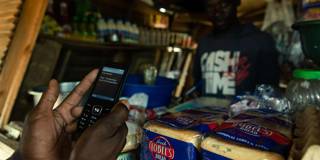Cash transfers offer a transformative solution to multidimensional poverty, by enhancing dozens of outcomes simultaneously. They have already proven effective, adaptable, and replicable, and now they are becoming more attainable every year with growing mobile coverage and improved digital infrastructure.
LOMÉ – For decades, the international community has grappled with the challenge of ending extreme poverty, which is the leading Sustainable Development Goal for 2030. Despite some progress, we remain far off track, with an estimated 700 million people still struggling to survive on less than $2.15 per day. Unlike in previous decades, however, we now have a solution that can be scaled up rapidly to accelerate the end of extreme poverty: direct cash transfers to the poorest households.
The concept itself is not new. Cash aid has proven effective, especially in the face of emergencies. During the COVID-19 pandemic, one of every six people in the world received some cash assistance. Direct transfers are powerful tools for helping individuals to take control of their lives and invest in their families’ well-being. That is why high- and middle-income countries are increasingly incorporating cash aid as a central part of their social safety nets. Still, it is estimated that less than 5% of the $200 billion spent annually on international development is allocated to cash transfers.
The positive impact of cash transfers is well-documented and undeniable. The upshot from more than 300 randomized control trials is that transfers can boost incomes more than twofold; increase school enrollment and entrepreneurship; decrease skipped meals, illness, and depression; and reduce domestic violence. Importantly, they neither reduce hours worked nor increase spending on temptation goods like tobacco and alcohol. Better still, every $1 transfer has a spillover effect of around $2.50 in the local economy. Three years after the transfer, recipients are still earning more and are better educated. Recent research from Kenya showed that a $500 lump-sum cash transfer was particularly effective in empowering families to make income-generating investments.

LOMÉ – For decades, the international community has grappled with the challenge of ending extreme poverty, which is the leading Sustainable Development Goal for 2030. Despite some progress, we remain far off track, with an estimated 700 million people still struggling to survive on less than $2.15 per day. Unlike in previous decades, however, we now have a solution that can be scaled up rapidly to accelerate the end of extreme poverty: direct cash transfers to the poorest households.
The concept itself is not new. Cash aid has proven effective, especially in the face of emergencies. During the COVID-19 pandemic, one of every six people in the world received some cash assistance. Direct transfers are powerful tools for helping individuals to take control of their lives and invest in their families’ well-being. That is why high- and middle-income countries are increasingly incorporating cash aid as a central part of their social safety nets. Still, it is estimated that less than 5% of the $200 billion spent annually on international development is allocated to cash transfers.
The positive impact of cash transfers is well-documented and undeniable. The upshot from more than 300 randomized control trials is that transfers can boost incomes more than twofold; increase school enrollment and entrepreneurship; decrease skipped meals, illness, and depression; and reduce domestic violence. Importantly, they neither reduce hours worked nor increase spending on temptation goods like tobacco and alcohol. Better still, every $1 transfer has a spillover effect of around $2.50 in the local economy. Three years after the transfer, recipients are still earning more and are better educated. Recent research from Kenya showed that a $500 lump-sum cash transfer was particularly effective in empowering families to make income-generating investments.